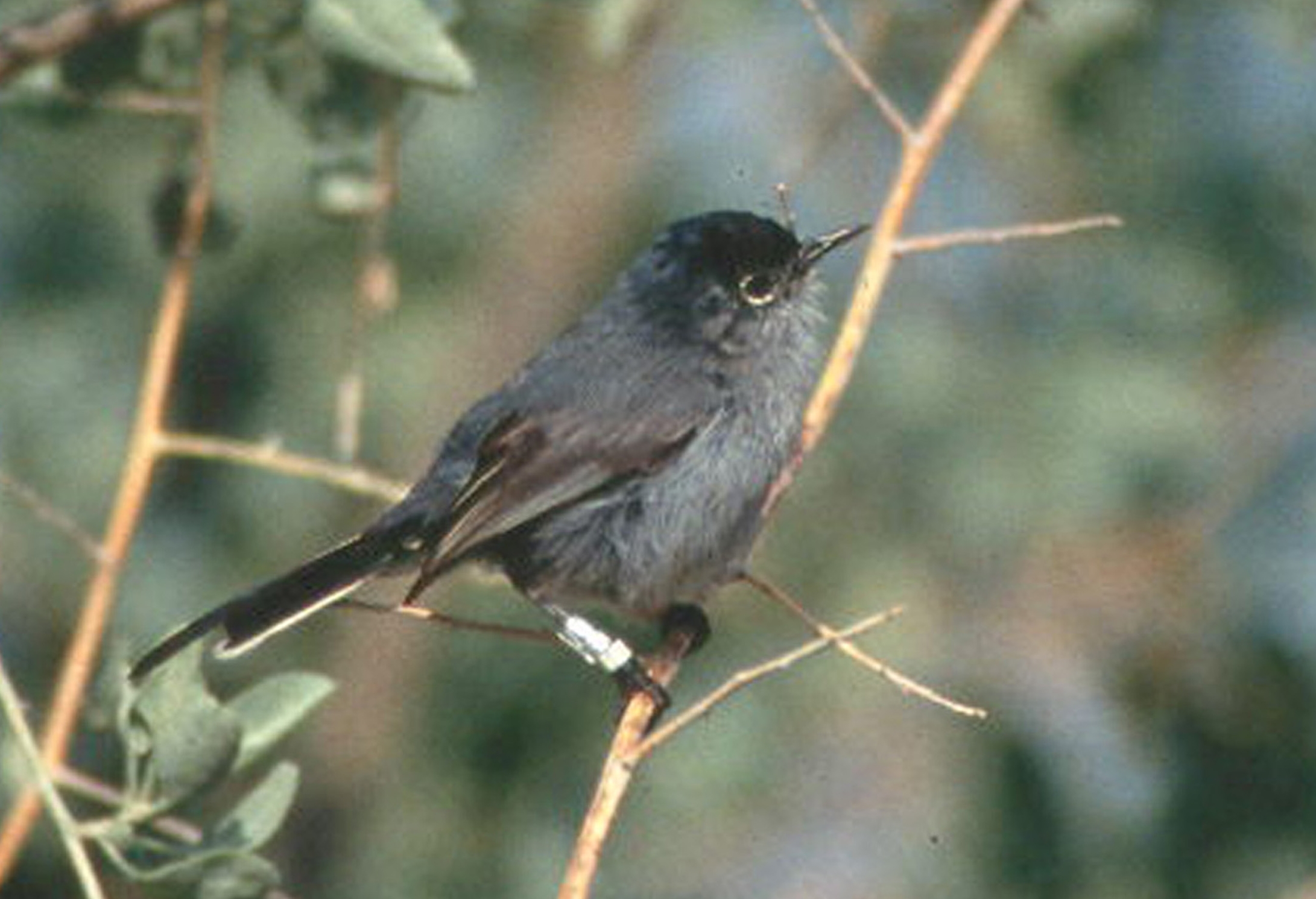- Gnatcatcher
Taxobox
name = Gnatcatchers

image_caption = "Polioptila californica "
regnum =Animal ia
phylum = Chordata
classis = Aves
ordo =Passeriformes
subordo =Passeri
familia = Polioptilidae
familia_authority = Baird, 1858
subdivision_ranks = Genera
subdivision = "Microbates Ramphocaenus Polioptila "The 15-20 species of smallpasserine bird s in the gnatcatcher family occur in North andSouth America (except far south and highAndean regions). Most species of this mainlytropical andsubtropical group are resident, but theBlue-gray Gnatcatcher of the USA and southernCanada migrates south in winter. They are close relatives of thewren s.These dainty birds are intermediate between "
Old World warbler s" andwren s in their structure and habits, moving restlessly through the foliage seeking insects. The gnatcatchers are mainly soft bluish grey in colour, and have the typical insectivore's long sharp bill. Many species have distinctive black head patterns (esp. males) and long, regularly cocked, black-and-white tails. The skulking gnatwrens are browner, more thickset, and with proportionally shorter tails and longer bills.The gnatwrens typically occur in the undergrowth of dense, often humid, forest, while gnatcatchers, depending on the species involved, occur in anything from dry scrubby habitats (e.g. the California Gnatcatcher) to the canopy of humid Amazonian forest (e.g. the Guianan Gnatcatcher). The North American species nest in bushes or trees, but the breeding behavior of several of the
Neotropical species is essentially unknown.A species new to science, the
critically endangered Iquitos Gnatcatcher "Polioptila clementsi ", was first described in 2005. This species is a member of the Guianan Gnatcather "Polioptila guianensis " complex, which recently has been proposed split into three species (four w. the Iquitos Gnatcatcher), but not all authorities have accepted this (e.g. SACC). Furthermore, other groups should possibly be split, notably the Tropical Gnatcather "Polioptila plumbea " and Masked Gnatcather "Polioptila dumicola " complexes, but at present scientific papers on these matters are lacking.* Family Polioptilidae
** Genus "Microbates "
***Collared Gnatwren , "Microbates collaris"
***Tawny-faced Gnatwren , "Microbates cinereiventris"
** Genus "Ramphocaenus"
***Long-billed Gnatwren , "Ramphocaenus melanurus"
** Genus "Polioptila "
***Blue-gray Gnatcatcher , "Polioptila caerulea"
***Cuban Gnatcatcher , "Polioptila lembeyei"
***California Gnatcatcher , "Polioptila californica"
***Black-tailed Gnatcatcher , "Polioptila melanura"
***Black-capped Gnatcatcher , "Polioptila nigriceps"
***White-lored Gnatcatcher , "Polioptila albiloris"
***Guianan Gnatcatcher , "Polioptila guianensis"
****Rio Negro Gnatcatcher , "Poliptila (guianensis) facilis"
****Para Gnatcatcher , "Polioptila (guianensis) paraensis"
***Iquitos Gnatcatcher , "Polioptila clementsi"
***Tropical Gnatcatcher , "Polioptila plumbea"
****Maranon Gnatcatcher , "Polioptila (plumbea) maior"
****White-browed Gnatcatcher , "Polioptila (plumbea) bilineata"
***Creamy-bellied Gnatcatcher , "Polioptila lactea"
***Slate-throated Gnatcatcher , "Polioptila schistaceigula"
***Masked Gnatcatcher , "Polioptila dumicola"
****Berlepsch's Gnatcatcher , "Polioptila (dumicola) berlepschi"References
* Atwood, J, and S. Lerman (2006). Family Polioptilidae (Gnatcatchers). Pp. 350-377 in: del Hoyo, J., A. Elliott, and D. Christie. eds (2006). "
Handbook of Birds of the World " Vol. 11. Old World Flycatchers to Old World Warblers. Lynx Edicions, Barcelona. ISBN 978-84-96553-06-4* Del Hoyo, J.; Elliot, A. & Christie D. (editors). (2006). "
Handbook of the Birds of the World ". Volume 11: Old World Flycatchers to Old World Warblers. Lynx Edicions. ISBN 849655306X.* Whitney, B., and A. Alonso (2005). "A new species of gnatcatcher from the white-sand forests in northern Amazonian Peru with revision of the Polioptila guianensis complex." Wilson Bull. 117(2): 113-210.
External links
* [http://ibc.hbw.com/ibc/phtml/familia.phtml?idFamilia=140 Gnatcatcher videos] on the Internet Bird Collection
Wikimedia Foundation. 2010.
